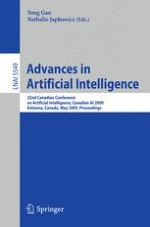This book constitutes the refereed proceedings of the 22st Conference of the Canadian Society for Computational Studies of Intelligence, Canadian AI 2009, held in Windsor, Canada, in May 2008. The 30 revised full papers presented together with 5 revised short papers and 8 papers from the graduate student symposium were carefully reviewed and selected from 75 submissions. The papers present original high-quality research in all areas of Artificial Intelligence and apply historical AI techniques to modern problem domains as well as recent techniques to historical problem settings.
